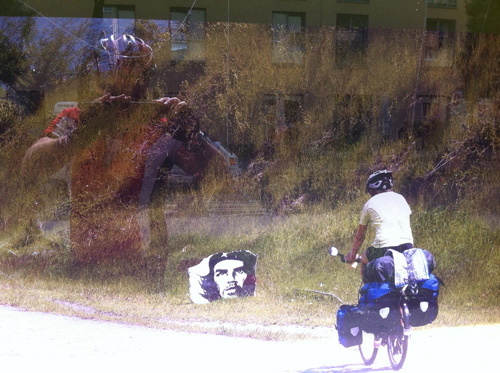
fno.org
|
|
| Vol 21|No 1|September 2011 | |
| Please feel free to e-mail this article to a friend, a principal, a parent, a colleague, a teacher librarian, a college professor, a poet, a magician, a vendor, an artist, a juggler, a student, a news reporter or to anyone else you think might enjoy it. | |||||||
Where is the off switch?By John Mikton, ©2011, all rights reserved.About author
|
|
||||||
|
Can we really disconnect from devices, email, social networks, the internet and digital life in general? Being caught up in a cycling trip for me is the easiest way to disconnect from all the rings, tasks, needs, wants, musts and maybes we get caught up in our digital life. An element of isolation and the tempo provide a good way to unwind and coach myself to be okay with the disconnection. The daily cycling, in an isolated environment, provides often limited cell reception, rare internet and few digital devices. This experience on the bicycle gives me the opportunity to create head space and day dreaming hours to clear out the mind and fall into a different time span and a grounded feeling. You generate in your head space for nothing.
For my generation and others prior to the explosion of the internet, we experienced an environment of limited connectedness, tied to a land line, pay phone, letters, fax, face to face, newsgroups, bulletin boards, and then email. Our privacy was shaped within a connection with a friend or two or a small circle of friends/acquaintances. The norms were based on word of mouth, hearsay, rumors, and reputations forged live — in front of friends/acquaintances or through media limited to small groups of folks for viewing or interaction. Often it became an issue of our word vs. their word. There was no digital footprint and it was harder accessing a paper trail. This experience equipped my generation and others with a counter-balance and a point of reference — an alternative to our current nonstop connectivity and diminishing privacy.
The perception and understanding of privacy and non stop connectivity has changed. For many of today’s online users, there is no point of reference or experience of not having a digital footprint, of not being connected 24/7. There is no understanding of privacy in the context of the pre-internet world. A social media openness is the norm of privacy today for a whole set of children and young adults. This shift can be uncomfortable for some, but it is here. The shift has happened in the background of our awareness to certain degree. My generation's concept of privacy, balance and connectivity is framed with a memory and life experiences without these new developments. Today children and young adults are framing their understanding and experiences based on a new social bargain where connectivity is a non negotiable ingredient to socialization both professional and personal. Connectivity is a must. Cell phones will keep Mom and Dad in touch with your whereabouts. Education demands mobile technology as a learning platform. We see commerce, entertainment, government and information all delivered mostly online. As with any changes in life you gain things and you loose things. Privacy and connectivity have changed and will continue to evolve in ways that will be be viewed by some as a paradigm shift, others as the norm and for others as a necessary evolution of our digital life. Today the off switch is no longer available! Even while we sleep or disconnect for a moment, emails, images, wall postings, and our digital footprints are active, being viewed, shared, forwarded, and catalogued — leaving a permanent digital trail. As individuals and a society we will need to find the spaces to disconnect on our own. This ability to disconnect — to find balance and space for nothing — must become a learned skill and behavior. But the challenge is enormous, because for many of our students who have no point of reference to a unconnected world, there is no previous learning or points of reference to build upon. As a society what does it mean when our digital footprints are available to anyone online, anytime, with any type of devices 24/7? This issue needs to become part of our educators' planning in schools and, eventually, part of the curriculum. Even if a new generation has not experienced a disconnected world, deep thinking and reflection (the space for nothing) is a crucial part of our collective historical heritage — the many moments when philosophers, artists, musicians, and thinkers sat with space for nothing so they could create marvels.
http://beyonddigital.org/2011/08/28/where-is-the-off-switch |
|||||||
|
|
|||||||
|
Copyright Policy: Materials published in From Now On may be duplicated in hard copy format if unchanged in format and content for educational, nonprofit school district and university use only and may also be sent from person to person by e-mail. This copyright statement must be included. All other uses, transmissions and duplications are prohibited unless permission is granted expressly. Showing these pages remotely through frames is not permitted. |
|||||||

This new book will begin shipping in September 2011.



